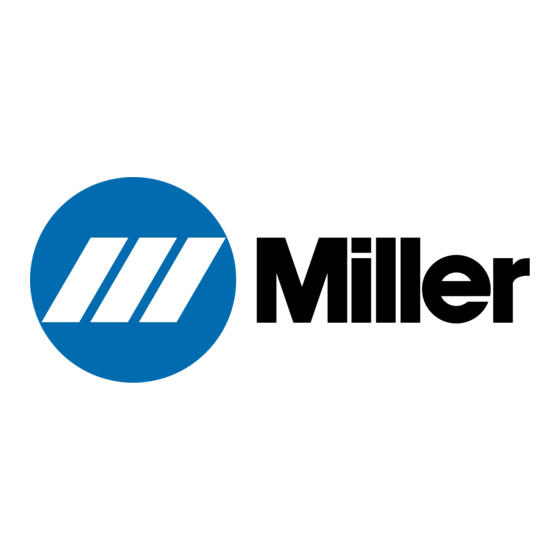Miller 900019 Manual de instalación y funcionamiento - Página 10
Navegue en línea o descargue pdf Manual de instalación y funcionamiento para Sistema de soldadura Miller 900019. Miller 900019 25 páginas.

90
80
70
60
(#1
-J
0
40
C
30
20
10
0
cuit
voltage
to reduce power
demand.
The LOW
ampere
range
utilizes
a
high
open cir
cuit
voltage
to
assure
arc
flexibility
and it is
always
recommended that the
LOW range be used for hard
surfacing,
alloy application,
and small electrodes
where
the
average
current
used
is
155
or
less.
4-6.
FINE CURRENT CONTROL
Select the desired
welding
current within the
range
by rotating
the Fine Current
Adjustment
Control
on
the front of the
welding
machine.
A current
indicator
on
the upper
left
part
of the control
panel
shows the
current in accordance with
thecurrentrangeinuse.
4-7.
ON-OFF POWER SWITCH
The Power switch controls the
primary
line power
to
the
welding
transformer.
When
the switch is
placed
in the ON
position,
open
circuit
voltage
will
be
impressed
across
the Work and Electrode
re
ceptacles.
4-8.
SHIELDED METAL-ARC
(SMAW)
WELDING
(Figure
4-3)
This
welding
machine
will handle all
good quality
mild
steel,
ac
and
ac/dc
electrodes from
5/64
to
3/16
diameter with the
exception
of low
hydrogen
and iron
powder
coated electrodes.
Iron
powder
coating
requires
higher
arc
voltages
for
the
given
current.
The
use
of
iron
powder
coated electrodes
in the
excess
of
5/32
diameter is not recommended
for this
model
welding
machine.
The
high
open circuit
voltage
of 80 volts available
on
the low
ac
current
range
of this
welding
machine
makes it
possible
to
use some
of the so-called hard
to
run
electrodes such
as
stainless steel and low
hydrogen
up to
3/32
and
possibly 1/8
diameter.
4-4.
VOLT-AMPERE CURVES
(Figure
4-2)
The
volt-ampere
curves
show the
output
volt
age available
at any
given
output
current within the
limits of the minimum and maximum current control
setting
on
each range.
With the
use
of the volt-am
pere curves, it is
possible
to
determine the
am
perage
required
for
a
particular
load
voltage.
In
metallic
arc
or
coated
electrode
welding,
it is
impossible
for the
operator
to hold
an
arc
length
which does not vary. This
varyingarc
length
causes
arc
voltage
to vary which in turn
produces
core
sponding changes
in
welding
current.
The
steeper
the
slope
of
the
volt-ampere
curve
within the weld
ing
range, the
lower
the
current
change
for
a
given
voltage change.
4-5.
CURRENT RANGES
The HIGH ampere
range
utilizes
a
low open cir
1,
Insert
the
jack
plug
from
the Work
Welding
Cable
into the WORK
receptacle
and
clamp
the
opposite
end
of the Work Cable to the work-
piece.
2.
Insert the Electrode Holder
welding
cable
jack
plug
into
either
the Electrode LOW
or
HIGH
receptacle.
A
slight
twist while
inserting
the
jack
plugs
into
the
receptacles
will
ensure
a
tight
connection.
If the
required
current is in
both
ranges,
use
the
LOW
range
receptacle
as
this will
provide
better current
control.
3.
Turn the Fine Current
Adjustment
Control to the
desired
welding
current.
4.
Place
the
Power
switch
In
the
ON
position.
5.
Place
an
electrode of proper
type
and size into
the
Electrode
Holder and
commence
welding.
6.
Readjust
the
current
control
if
necessary.
7.
After the
welding job
is
completed,
break the
arc
and
place
the
Power
switch
in the
OFF
position.
4-9.
ARC TORCH OPERATION
A carbon
arc
torch may be usedwith this
welding
machine.
With
a
carbon
arc
torch it is
possible
to
weld and braze metals that
ordinarily
are
considered
weldable
only by
the
oxyacetylene
method.
Itis
es
pecially
adaptable
for
brazing, soldering,
pre
heating
and hard
surfacing.
A carbon
arc
torch
maintains
a
high
temperature
arc
between two
car
bons.
Welds
produced
with this
type
of torch
are
sound,
strong,
and
free
from
porosity.
The
parent
metal
or
welding
rod
is used
as a
filler.
25
50
75
100
125
150
175
200
225
AC AMPERES 180 AMP MODEL
96-900
001-1
90
80
70
60
~
50
-a
0
>
40
U
C
30
20
10
0
50
100
150
200
250
300
AC AMPERES 225 AMP MODEL
EB-900 019-1
Figure
4-2.
Volt-Ampere
Curves
AA-900 001-2
Figure
4-3. AC
Welding
Connections
4
Page
8
